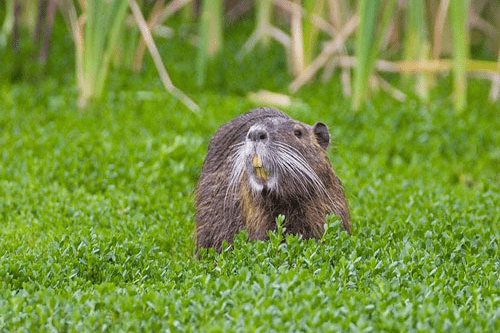Operational Activities: Nutria
Nutria ( Myocastor coypus) are large, semi-aquatic rodents that are native to South America. The species is invasive in the United States and established in 17 States.
Nutria cause extensive damage to wetlands, agricultural crops, and structural foundations such as dikes and roads. They may also threaten human health and safety and serve as a reservoir for tularemia and other diseases. Integrated management solutions to nutria problems may include habitat manipulation, population management, and innovative approaches and tools generated by research.
Ecology and Biology
Understanding Wildlife, Damage, and Management
Nutria are invasive semi-aquatic rodents that were introduced into the United States in 1899. The species has since dispersed across much of the southern and eastern parts of the country.
They were brought to the United States in the late 1800s for the fur trade. In addition to damaging vegetation and crops, nutria destroy the banks of ditches, lakes, and other water bodies. The long term damage nutria cause to marsh vegetation subsequently affects the plant and animal species that also inhabit those areas.
Nutria conflicts with people vary widely. Their ease of mobility on land and in water enable them to rapidly disperse into new areas. Nutria damage is evident to varying degrees in every area they are found.
Damage to Agriculture
In the United States, sugarcane and rice are the primary crops damaged by nutria, but they will also eat corn, milo, sugar and table beets, alfalfa, wheat, barely, oats, peanuts, and various melons.
Damage to Property
Nutria burrows, which can extend up to 150 feet long, cause extensive damage to stream banks, canals, irrigation structures, levees, and other property. Their burrows can damage flood control levees that protect low lying areas; weaken the foundations of reservoir dams, buildings, and roadways; and erode the banks of streams lakes, and ditches. Nutria girdle fruit, nut, and shade trees and ornamental shrubs, and they may dig up lawns and golf courses when feeding on the roots and shoots of sod grasses.
Health and Safety Concerns
Nutria are vectors for wildlife diseases including tuberculosis and septicemia, which are transmissible to people, pets, and livestock. Nutria feces and urine can contain parasites such as nematodes, blood flukes, tapeworms, and liver flukes that may contaminate drinking water supplies and swimming areas used by people.
Damage to Natural Resources
Nutria cause damage to marshes and other wetlands. Unlike native rodents, nutria consume not just the succulent leafy portions of marsh plants, but also the roots, rhizomes, and tubers, leading to complete destruction of the plant. In most cases, nutria damage to marsh vegetation and soils is so severe that the marsh is converted to open water.
Nutria have removed much of the vegetation in this section of Chesapeake Bay marsh. Two years after nutria removal, this same section of Chesapeake Bay marsh has become revegetated.
WS is leading the first large-scale North American effort to eradicate a mainland population of nutria on the Delmarva Peninsula in Maryland where the rodents have devastated coastal Chesapeake Bay marshes. Also, WS works to assist with nutria control in the Gulf Coast states.
Executive Order 13112 (1999) directs Federal agencies to provide leadership in controlling invasive species and preventing their introduction and spread. WS provides technical assistance and direct management for nutria conflicts, and has management programs to eliminate nutria in a number of states. In Maryland, Wildlife Services' personnel have partnered with the U.S. Fish and Wildlife Service, the U.S. Geological Survey, the Maryland Department of Natural Resources and others to implement a large scale nutria eradicate program and to develop new nutria detection and monitoring techniques including remote triggered cameras, call-back surveys, and other means of detecting low density nutria populations.
Although nutria are an invasive species, they are protected as furbearers in some states. Local wildlife authorities should be consulted before control methods are implemented.
To contact your WS State Office, call 1-866-4USDAWS (1-866-487-3297).


